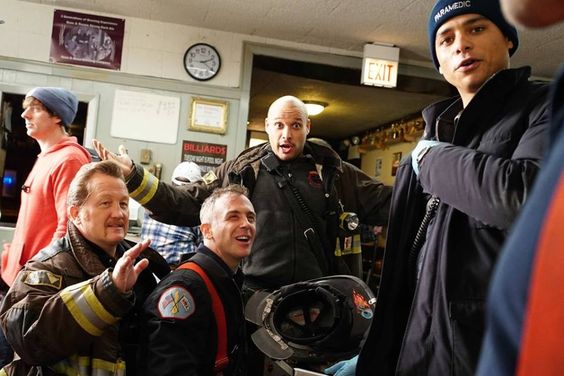
Introduction: A Unified Story Across Three Shows – Did It Work?
The One Chicago franchise is known for its incredible storytelling across multiple interconnected series, from Chicago Fire to Chicago Med and Chicago PD. But when the Fall finales of 2024 aired, there was something strangely familiar about them. All three shows told what seemed like the same story but in different formats. While each series maintained its unique tone and style, they all explored very similar themes of danger, sacrifice, and resolution.
In this article, we’ll take a deeper look at how Chicago Fire, Chicago Med, and Chicago PD used similar narratives in their Fall finales and why this approach, though bold, works so well within the One Chicago universe.
The Core Theme: A Shared Crisis That Binds Them All
A Sense of Urgency That Unites All Three Shows
Across all three One Chicago shows, the Fall finales centered on one central crisis: a dangerous situation that tested the characters’ skills, courage, and relationships. Whether it was battling a fire, saving a life, or solving a crime, the stakes were incredibly high. The tension built up throughout each episode, culminating in intense moments of action and personal sacrifice.

Each show approached the crisis in its own way, but the urgency and high stakes remained constant. This unifying theme across all three shows helped create a shared emotional experience for the audience. Viewers felt the same sense of dread, hope, and resolution no matter which show they were watching.
Chicago Fire: Saving the Day – A Hero’s Sacrifice
A Fire That Threatened Everything
In Chicago Fire, the Fall finale focused on a blazing fire that put both the firefighters and civilians in mortal danger. As usual, the members of Firehouse 51 went above and beyond, risking their lives to protect others. The fire acted as a catalyst for the characters to step up and prove their mettle under extreme pressure.
At the heart of the episode was a central theme of sacrifice. Characters like Stella Kidd and Matthew Casey faced difficult decisions where they had to put the needs of others above their own. The fire wasn’t just a literal threat – it symbolized the emotional toll of constantly living on the edge as a firefighter.
The Importance of Teamwork in a Crisis
The episode highlighted how teamwork and trust are essential in moments of crisis. The firehouse team had to rely on one another, even when faced with unexpected complications. This created a deep sense of unity, showing that despite the individual challenges each firefighter faces, they are stronger when they come together as a team.
Chicago Med: Life on the Line – The Power of Healing
A Medical Emergency That Tests Every Doctor’s Resolve
Meanwhile, Chicago Med presented a crisis that was just as intense, but in a different context. A medical emergency, involving a life-threatening situation, tested the staff at Gaffney Medical Center. Doctors, nurses, and medical technicians had to work under extreme pressure to save lives, mirroring the intense action seen in Chicago Fire but through the lens of healthcare.

The theme of sacrifice was also prevalent in Chicago Med. In this episode, doctors were forced to make gut-wrenching decisions that could either save or cost lives. The characters had to confront their own limitations and navigate their personal struggles while trying to keep patients alive.
The Personal Cost of a Medical Crisis
One of the more poignant aspects of this Fall finale was the personal cost of being a healthcare worker. With so many patients depending on the medical staff, each character had to sacrifice something of themselves, whether it was their time, energy, or even their mental health. This emotional toll gave the episode an intensity that mirrored the sacrifices made by the characters on Chicago Fire.
Chicago PD: The Thin Blue Line – A Crime That Hits Too Close to Home
A Dangerous Crime That Shakes the Force
Chicago PD also followed a similar thread in its Fall finale, where a crime placed its officers in a dangerous, high-stakes situation. The episode revolved around a case that was personal to the officers – one that tested their ability to solve a case while maintaining their own moral compass.
The crisis in Chicago PD was perhaps the most intense of the three, as it not only involved high-stakes crime-solving but also highlighted the personal toll on officers who were forced to confront their own vulnerabilities. In a case that brought the team face-to-face with a dark truth, the episode explored the emotional and physical sacrifices that come with life on the force.
Facing Internal Conflict and External Threats
Similar to the challenges faced by the firefighters and doctors, the Chicago PD team was forced to deal with internal conflict – balancing personal morals with the pressure of solving a crime. The emotional conflict added depth to the action, showcasing the humanity of the officers while maintaining the series’ trademark suspense and drama.
Why Telling the Same Story Across Three Shows Works
A Consistent Message Across the One Chicago Universe
By telling the same story across all three shows, One Chicago created a unified message about sacrifice, teamwork, and resilience. The different settings allowed the franchise to explore the same themes in unique ways, using the distinct nature of each profession to bring fresh perspectives on the crisis at hand.
What makes this approach so effective is the emotional resonance it creates. Fans who watch multiple One Chicago shows get to see the same kind of emotional depth and high stakes in different contexts, enhancing their connection to the characters. The shared themes also allow for crossover moments, where the stories from one show bleed into the next, making the entire One Chicago universe feel interconnected.
The Power of Storytelling in Different Contexts
Each of the One Chicago series operates within its own sphere – firefighting, healthcare, and law enforcement. However, all three professions share the same core values: protecting others, working as a team, and making difficult decisions in the face of danger. By exploring similar crises within these contexts, the shows reinforce these values and allow the audience to see them through different lenses. This not only makes for compelling television but also strengthens the emotional weight of the stories.
Impact on Fans: How the Fall Finales Left Us Wanting More
Creating Anticipation for the Next Chapter
After these Fall finales, fans of the One Chicago franchise were left at the edge of their seats, eagerly awaiting what would come next. The shared crisis across the three shows created a sense of continuity, where the events of one episode might have a ripple effect on the others. This interconnected storytelling method has been a hallmark of One Chicago, and the Fall finales proved just how well it works.
By taking a similar story and telling it in three different ways, the writers have built a sense of unity across the franchise, making each show feel like a piece of a larger puzzle. The result is a thrilling and emotionally charged narrative that keeps fans coming back for more.
Conclusion: One Chicago Masterfully Weaves the Same Story in Three Ways
The Fall finales of Chicago Fire, Chicago Med, and Chicago PD might have told similar stories, but each series explored those themes in unique and captivating ways. Whether through fire, medicine, or law enforcement, the central themes of sacrifice, teamwork, and resilience were evident in all three episodes. This storytelling approach not only tied the shows together but also deepened the emotional connection fans have with the One Chicago universe.
While the stories may have been similar, the way they were presented kept the audience engaged and invested in the fate of each character. By telling the same story in three different ways, One Chicago proved once again that great storytelling doesn’t have to be repetitive – it just needs to be creative.
FAQs
1. Why did One Chicago tell the same story across all three shows? The Fall finales used a similar story across the three shows to reinforce key themes like sacrifice, teamwork, and resilience. Each series explored these themes within its own context, creating a unified experience for viewers.
2. What made the Fall finales so impactful across all three shows? Each Fall finale was impactful because it involved high-stakes situations that challenged the characters emotionally and physically. The crises they faced forced them to make difficult decisions, creating suspense and emotional depth.
3. How do the shows connect with each other through these shared storylines? The shared storyline connects the shows by focusing on universal themes – protecting others, making tough decisions, and working as a team. This interconnected approach helps build anticipation and continuity across the One Chicago universe.
4. Did all three shows resolve their crises in similar ways? While the crises in each show were different, the resolution was similar in that each group of characters relied on their teamwork and skills to solve the problem. The emotional stakes were also resolved through personal growth and sacrifice.
5. Can we expect more crossovers like this in the future? Given the success of these Fall finales, it’s likely that One Chicago will continue to explore shared storylines across its three shows. This approach has proven to be an effective
